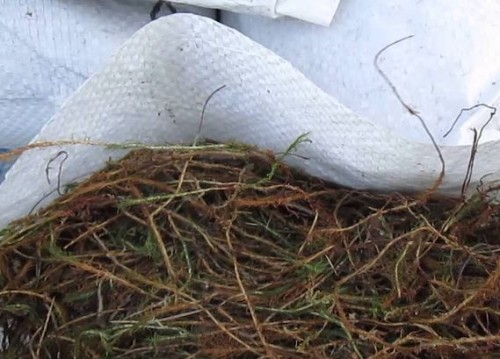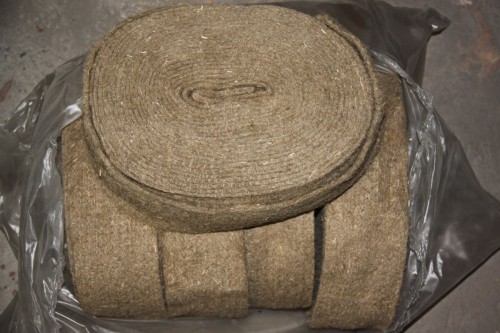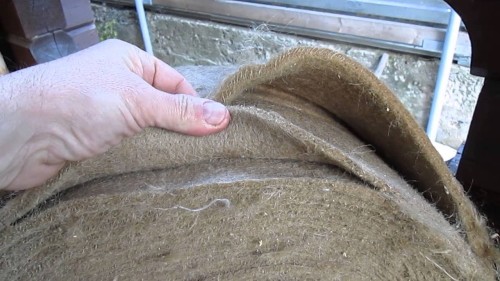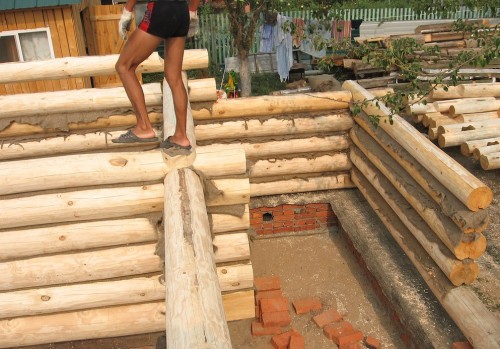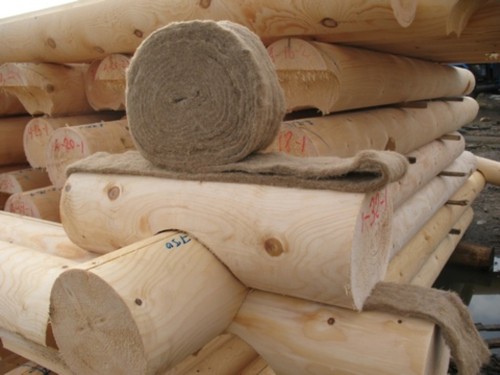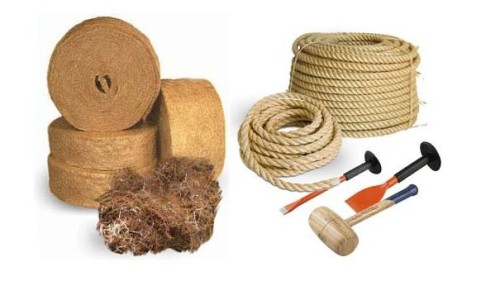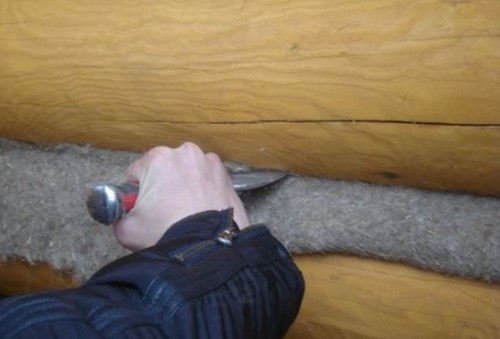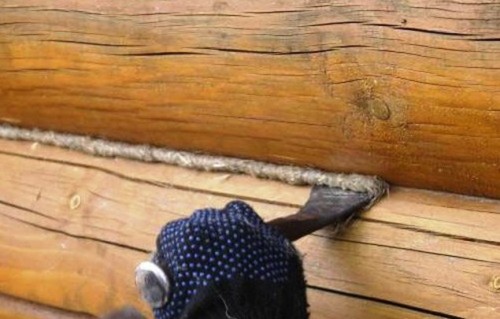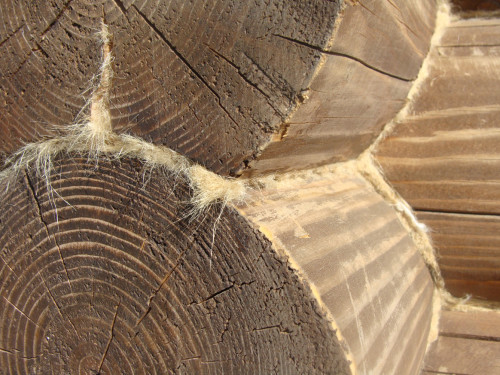Traditionally, during construction from a tree to compact the walls of a chub, a pantry is used with natural fibrous materials. With the onset of cold weather, it is possible to appreciate the result of such a work - the use of this technique will help seal the joints of the logs, exclude purge and warm up the construction. In addition, with the help of cacopa, it is also possible to eliminate srubes. To qualitatively to cross the walls, some features of the implementation of this process should be taken into account.
Content
Why do you need a cutter
For several centuries ago, the construction of houses from logs was most popular in Russia, while professional cavrops transferred secrets of mastery from generation to generation. Such masters were very in demand, because they could adjust the results of construction, eliminating the sounds of log cabins and insulating the slots between the logs. Over time, a very effective methodology for these works was developed.
Currently, there is a new round of the popularity of the construction of wooden log cabins, because the construction of this type provides a comfortable atmosphere to accommodate in safe conditions. To make such a house with warm and cozy, it will be necessary to insulate it - for this it is necessary to carry out the pant of the walls.
Applicable materials for cacked
Natural materials are published in our latitudes for sealing the joints of a wooden log house - red moss, pass, felt, flax, hemp fiber. Currently, they added a jute insulation and flanutin, as well as modern sealants. To get a qualitative result of insulation, it is necessary to thoroughly think about the better the walls. The disadvantages of certain natural materials include their short-life and low hygroscopicity. It should also be taken into account that natural material is often subjected to insect attacks. When the pests are reproduced in the cavropka layer, the logo itself may be affected, so it will be necessary to pre-process the insulation with special impregnations.
Consider more popular varieties of material for cacopa cutters:
- moss - this natural and environmentally friendly material has therapeutic (antibacterial and tonic) properties. As a means for insulation of the walls, the moss successfully confronts the temperature drops, does not dry, absorbs moisture, but it does not deteriorate. Such a cutter of the cut is safe for health and durable;
- pacle - This fiber, representing the waste of primary processing of various luban cultures (for example, flax, and cannabis), is also traditionally used for cacopa. This material has excellent thermal insulation properties and is not subject to imminent decay;
- felt - represents not too suitable material for the cacopa, since, as the log cabin can recruit a significant amount of moisture and gradually deteriorate. In addition, in felt may be mole, in a short time, the eager for this insulation, in order to avoid this phenomenon, it should be impregnated with an antiseptic to it. If this insulation comes into disrepair, it will be necessary to spend a significant amount of work and time to clean the gaps and breakage cavities, and then to cross the log house again;
- jute fiber - this insulation material is popular for the performance of the cacked of log cabins, as it has high strength, flexibility and significant hygroscopicity, in addition, it does not start mol. The jute insulation evenly distributes heat in the house and along with the wood, it provides an optimal microclimate in it. With 80% humidity, the jute fiber remains dry to the touch, as no more than 20% of moisture absorbs. It should not be confused with jute felt containing linen fiber in its composition (this material does not have the desired strength, are affected by insects and rotting). Jute fiber is widely used to seal joints, gaps and crack cracks. Internet jute tape of various widths and thicknesses can be purchased in motges. This material is convenient to lay directly on the log house. This method of cacopa is light and very convenient;
- linovatin - This insulation is a nonwoven quilted material from pressed flax production, tougher compared to the jute ribbon. The flanutin has optimal water absorption, suitable density and rigidity for the insulation of the joints of the log. This material is produced in rolls, it is convenient to use it when carrying out cavinc by the method of "stretching";
- modern sealants - these funds are suitable for processing the joints of a cut from a rounded log or a qualitatively fitted conventional with semicircular grooves. This remedy should be selected, based on specific conditions - given the width of the gaps between the logs. It is worth considering that the sealant will not be able to independently provide full insulation. At the construction stage in a logberon between the logs, it is necessary to put the insulated layer of the jute canvas or flanity, then the joints of the joints will be enough for sealing the joints with the help of sealant.
Before laying in gaps between the logs, it will be necessary to pre-prepare material. The red swamp moss must be dried, otherwise the coincarnio layer with high humidity can lead to a damage of wood (it should be taken into account that if you cut this material, it will become crumb). To facilitate laying between logs of the insulation layer, moss can be mixed with packles. Felt will be necessary to handle formalin or other impregnation to protect against insects to avoid reproduction in it moths.
Crop's technology Sruba
It is worth considering that wood wood is a natural material, militant depending on various factors (the effects of weather conditions and the used tree processing methods). Over time, it is observed by wood drying, under the influence of which wooden logs can change the configuration and volume, as a result, gaps appear between them. If such cracks do not close, through them in the cold course of the year from the house will be driving warm - therefore, it will take much more fuel for heating in winter. At the same time, condensate will be formed outside the walls, which can lead to further damage to the wood of a church. To avoid such problems for building from logs, it will be necessary to perform a panty twice, and sometimes three.
When planning, how to praise a log house, it is necessary to take into account the following - even at the construction stage (during the laying of logs), it is necessary to provide work on basic warming of the construction. For this, the logs will be required to lay a layer of heat-insulating material - hemps, moss, flank, pacles or jute. These materials need to lay a uniform layer with a 4-5 cm release on both sides, flanutin or jute will also need to fix on the logs with a construction stapler. Package should be placed in such a way that its fibers lie in the direction perpendicular to the groove grooves.
Immediately after the assembly, the log house is not worth it, it is advisable to wait for its base shrinkage. At least six months after the construction, it is possible to proquire. As a rule, by that time there are already disadvantages of the built-up construction, and they can be effectively adjusted. After a half or two years, after the final shrinkage of the cut, it should be re-panty. It is important to note that after the cacopa, the log house is raised by 8-12 cm, so the finishing work should be postponed until the end of the embedders.
How to perform a carp of a cut with your own hands
It is worth noting that the process of a cutter of a cut with their own hands is quite time consuming and requires a thoughtful approach. Nevertheless, after studying the information provided and the choice of the most appropriate thermal insulation material, these works are quite realistic to perform independently.
Traditionally, special devices in the form of several types of blades (so-called cacopants) are used for the cutting of the cut. In addition to the metal (optimally steel) or a wooden blade, it will take a chisel to work or a chisel with a width of 20 mm, as well as rubber cizyanka.
Based on specific conditions for caulking, a wooden blade of suitable shape and thickness can be made independently from beech, oak or walnut. At the same time, it is required that her wood is softer a cut tree, otherwise there is a risk of leaving marked on the logs. The replacement shovel will be unusable to be replaced by the "reset" shovel. Steel cavincons of the curved form are conveniently used to treat corner wrists - such devices you can get deep into the design.
Methods of cakes
For the roasting cutter traditionally use one of the following techniques:
- "Stretching" - for this, insulated material in the form of a canvas or long strand must be stretched horizontally and attached to the joint of the logs, and then put the top edge into the slot using the blade. Next, it will be necessary on a small area to choose hanging down the ends of the material and roll it into the roller, and then the ravarity inside the gap. To do this, it is necessary to push it with a chisel, grabbing it with the image to facilitate the process. Gradually, the neighboring areas of the material should be grabbed, extending the roller and the tamping of it inside the gaps between the logs. Similarly, it is necessary to advance until all the slots are filled with insulation material;
- "In the set" - for this it is necessary to form a thickness of about 2 cm from the insulation material, twist them in the harness, and then wind into the ball. Next, we will need to unwind the harvested seal and score it into the slot between the logs with a seal with a blade and a blue. In places where the gaps are expanded, it will be necessary to minimize the harness in several layers of the loop of the desired thickness and plunder it into the gap.
Roller either harness will be retarded with a spatula or a chisel - from above, below and then in the central part. To facilitate the process of laying the heat-insulating material in the slice of the carp, the pants should be broken by a thorough. To cross the loghouse, all over the perimeter buildings should be consistently handled the seams in the bottom upward, gradually rising up from the crown to the crown.
The cutting technology of the cutter at first glance is simple, however, it is necessary to approach the performance of these works. It is necessary to pay attention to what can be caught in a completely one wall, and then it is not recommended to proceed to the processing of the following is extremely recommended, since there may be significant overcasts due to such actions, which will lead to the deformation of the church. It is also necessary to take into account that if it is unevenly crossing the logs outside and from the inside of the house, the angle of inclination of the planes of the vertical planes may change.
If, due to the cacopa, the log house is lifted by a whole crown, this is a sign that soon the logs can fall from the locks or the waders. This situation is extremely unwanted. To avoid the appearance of such problems, when working, you will need to regularly track the vertical and horizontal of the cut. As a result of high-quality work on the panty, the log house is raised by no more than 12-15 cm.



